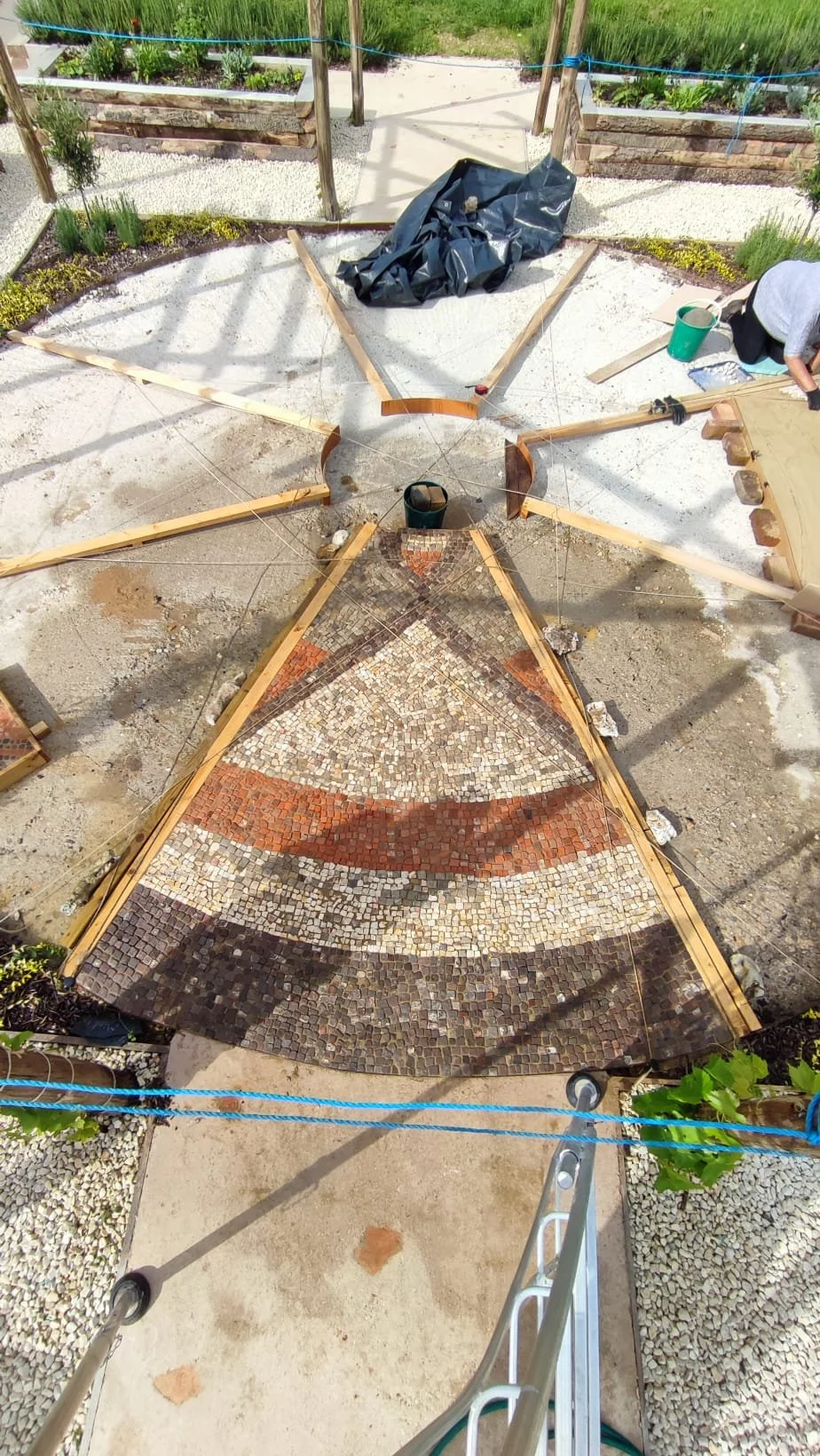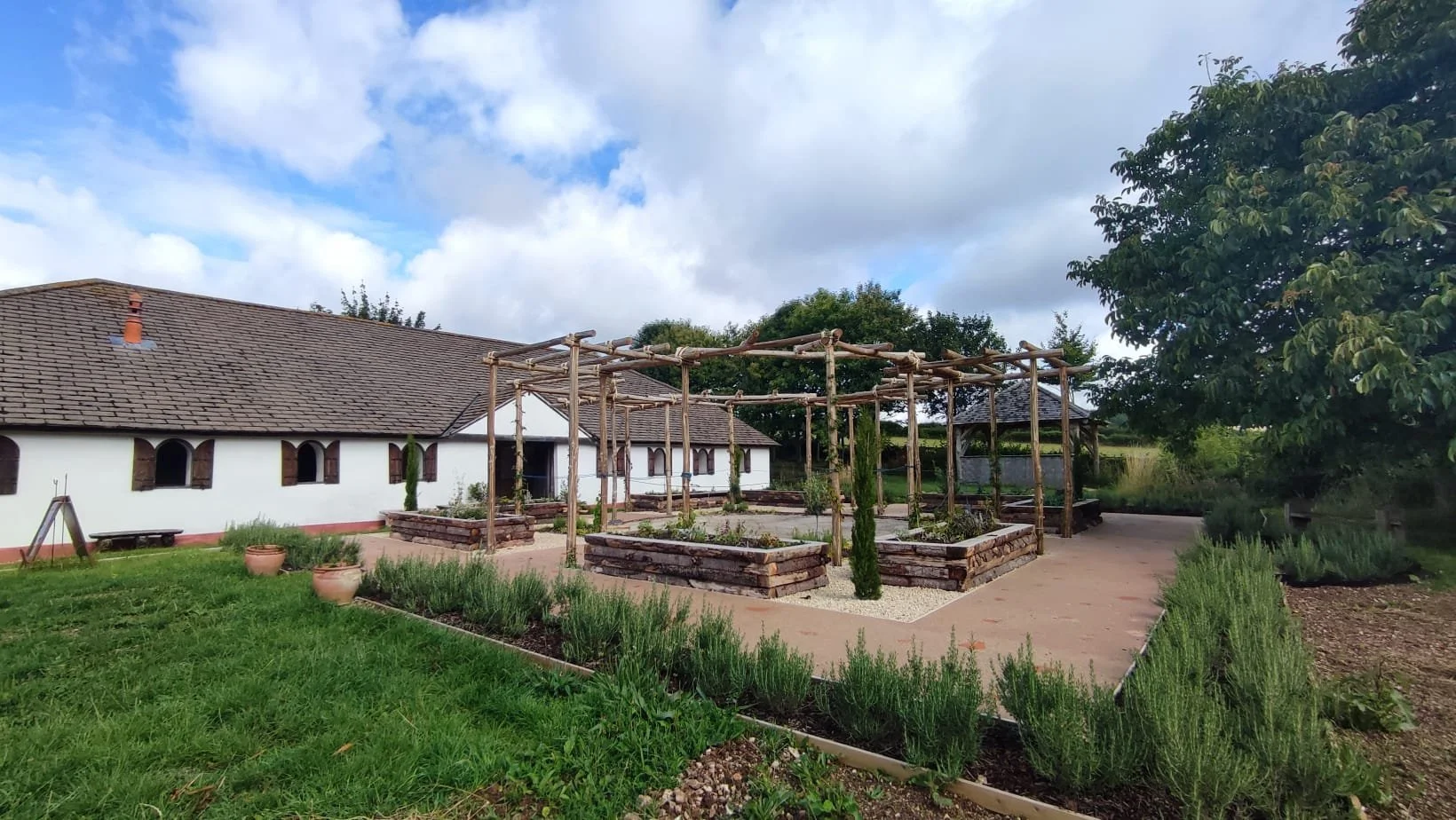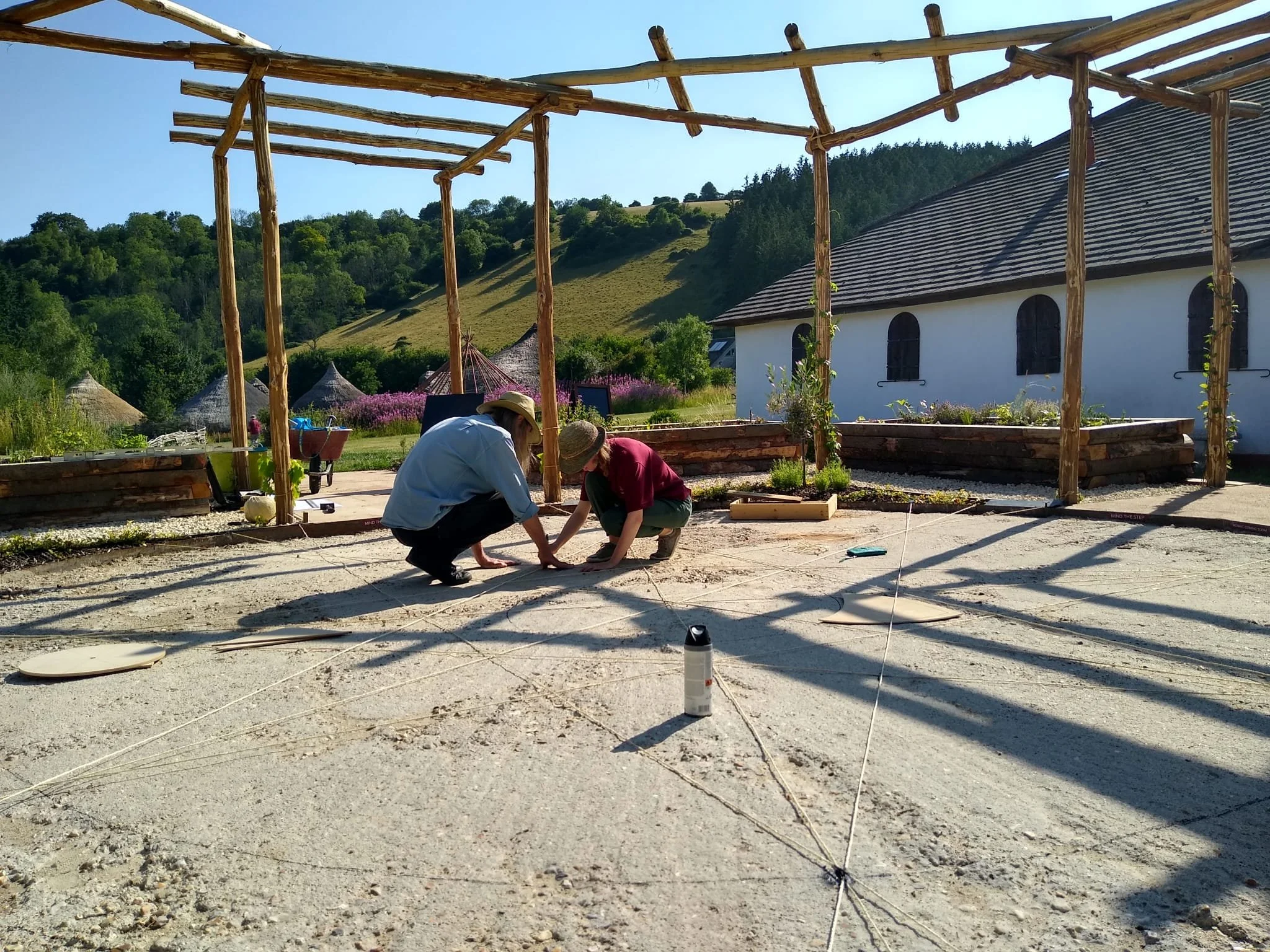Project Archaeologist Trevor Creighton shares the story behind our latest exciting project to create an outdoor mosaic in our new formal Roman garden.
The formal Roman garden under development
Laying out the Mosaic pattern framework
After months of planning we’re excited to be starting a new mosaic project at the farm this summer. This will be our third but, unlike the other two, our latest mosaic won’t be inside the Roman villa but outside, set in a beautiful new garden opposite the villa’s front door.
To build it, we’ll be using recycled tesserae set into a base of sand mixed with cement. The design of the new mosaic is the brainchild of Butser’s creative developer Rachel Bingham, with valuable input and elegantly made formwork for setting out the large, 25 square metre design from her father and Butser volunteer, John. It will feature a geometric design that resembles an eight-petaled flower, surrounded by concentric circles, contrasted with different coloured stone and terra cotta tesserae (tesserae are the small, roughly cubic tiles that make up the mosaic patterns). The mosaic will feature a central decorative design, like an eight-petaled ‘flower’ in the centre.
The geometric design for the Mosaic
It is a large version of a similar design found in the centre of our large indoor mosaic, which is in a room opposite the front door of the villa, just across the footpath from our garden. The original of that mosaic was uncovered in the excavation of the Roman villa that ours is based on, which was found at Sparsholt near Winchester. So, while there is no evidence of any outside mosaic at the original villa, the new mosaic design reflects one that we know existed in the original villa in the 4th century. We also have a beautiful Lararium, or household shrine, that sits at the rear of the villa’s mosaic room and it, too, features the same flower-like design. We think that the repetition of this motif gives a wonderful harmony and authenticity to our new garden mosaic and its relationship with the villa.
Calçada photographed in Madeira
We have little information about outdoor mosaics in the Roman world, so ours will be constructed in a similar way to a modern pavement, being laid into a dry mixture of sand and cement that will be wetted after the mosaic is laid. Once the water penetrates the sand and cement mix it will cause it to set and so stabilise the mosaic. This technique is very similar to the construction of calçada - type of mosaic cobblestone pavement used extensively in Portuguese streets and which in turn dates back hundreds of years.
Vitruvius, the great architectural commentator of the Roman world, described what we might call the ‘classic’ way of constructing a mosaic. His method involves laying down a base of coarse gravel or stones, on top of which is laid fairly coarse concrete, with a final, thin layer of fine, wet mortar laid across the top of that, into which the tesserae are set. This is clearly quite different from the method we are using. The reason for this is that it is not practical to lay a large, outdoor mosaic into wet mortar – doing that would create a lot of difficulties, not least because the mortar would set too quickly. The concrete and mortar used in making Roman mosaics was also somewhat different to the modern cement that we will be using, again for practical reasons.
Just in case you think we’re departing too much from the Roman model, it's worth pointing out that both Roman and modern cements are lime-based, as we'll see in the discussion below. And, despite Vitruvius’ excellent method, more mosaics probably deviated from his advice than obeyed it, and this included laying them over bases of sand. What's more, our recycled tesserae come from a demolished Roman villa! They came from a villa at Badbury in Wiltshire, which was destroyed by the M4 motorway when it cut through east-west just south of Swindon. They were rescued by Bryn Walters from the Association for Roman Archaeology, who has a long association with Butser and kindly donated for use here at the Farm.
After talking so much about the materials we are using to construct our mosaic, I thought it would be useful to have a brief discussion about them and the surprising history of their use, so here we go…
Mortars and concretes are mixtures of sand and/or gravel (called aggregate) bound together with a cement and water. Strictly speaking, cement refers to the dry binding material, which is usually made from burnt limestone and which hardens after being mixed with water. Mortars and concretes are very similar to each other in terms of the materials that go into making them. Typically, concrete has more cement and coarser aggregate to give it more strength. Mortar, on the other hand, is mixed with slightly less cement and a fairly fine sand. Concrete is used in things like building foundations, which need to be strong and resilient, whereas mortar is used for applications like binding stone and brick in walls and tesserae in mosaics. Modern cement, which is known as Portland cement, is actually very similar in composition to cements that have been used for 3000 or more years. But whereas ancient cements are essentially just burnt limestone, modern cements have additional materials added to them to make them harder and more durable.
Early lime-based concrete and mortars have been identified in the Middle East and dated to 1300 BCE, while some archaeologists claim they were used as much as 8500 years ago. Simple clay mortars have been identified in even earlier structures, such as in Jericho (one of the longest continuously occupied places we know of) – at around 10,000 BCE. Modern Portland cement, on the other hand, was only developed in 1824. The famous Roman cement was first described just over 2000 years ago and is a mixture of aggregate, water and burnt lime, which is usually made by burning limestone (such as chalk) but can be made by burning seashells.
The special ingredient that makes Roman concretes and mortars so durable is known as pozzolan. Pozzolans are essentially ground up burnt silica-rich materials. These can be manufactured simply by burning high silica clay, they can also be made from broken and crushed pottery and tiles, which is often seen in Roman concrete, or they can come from certain volcanic rock, such as is often found in Italy. In fact, the name pozzolan comes from the name of the Italian town Pozzuoli, which is near Naples. Pozzuoli is where the Romans mined the soft, clay-rich volcanic stone that was crushed and added to their mortars and concrete. Pozzolans make concretes and mortars stronger and, in particular, make them resilient against the corrosive effect of salt water. In fact, while modern concrete breaks down in salt water, Roman concrete gets stronger over time, and this is why we can still find intact underwater structures that are almost 2000 years old.
From what we know of surviving archaeological evidence, mosaics in the Roman world were used principally as indoor flooring, and occasionally on walls and even ceilings. Some of these indoor mosaics were on a vast scale and in spaces so vast that we might think of them as having brought the great outdoors indoors! We do, however, have evidence of some outdoor use, such as in pools and fountains and in colonnaded walkways that surrounded courtyards in large palaces. Mosaics were expensive investments and only accessible to the well off. While many hundreds of mosaic floors are known in Britain from the more than 350 years of Roman occupation (mostly just fragments), and doubtless many more have been destroyed or are yet to be discovered, it remains the fact that the vast majority of people did not have them in their homes (which is also the case in the rest of the Roman world). So, it’s natural that most people wanted to protect their investment by having them indoors, leaving the more lavish use in outdoor settings to the emperors and the super-rich.
2023 marks the 20th anniversary of the construction of the Roman villa at Butser so we wanted to add something special to the Roman area at the farm to mark the occasion. The formal garden and mosaic centrepiece will certainly allow us to do this in style!
Some of the volunteer team working on the first segment of the garden mosaic, August 2023.
This whole project has been made possible by a generous donation in memory of Joan Rundle, a long term volunteer, Friend and supporter of Butser whose special interest was in Roman gardens. We are very grateful to Joan and to her husband Ed Rundle for his ongoing support.
We hope you can visit Butser Ancient Farm to see our progress over the coming months as the garden grows and develops!






